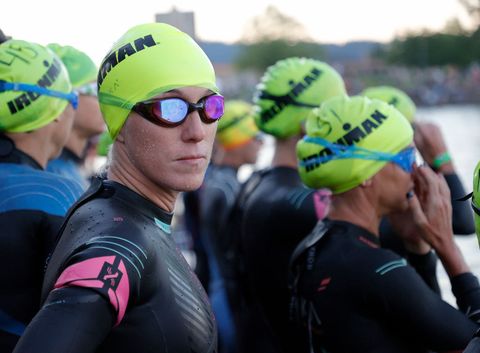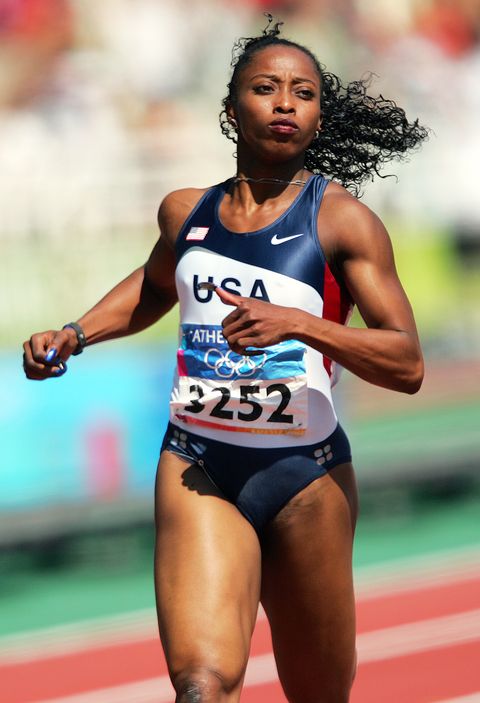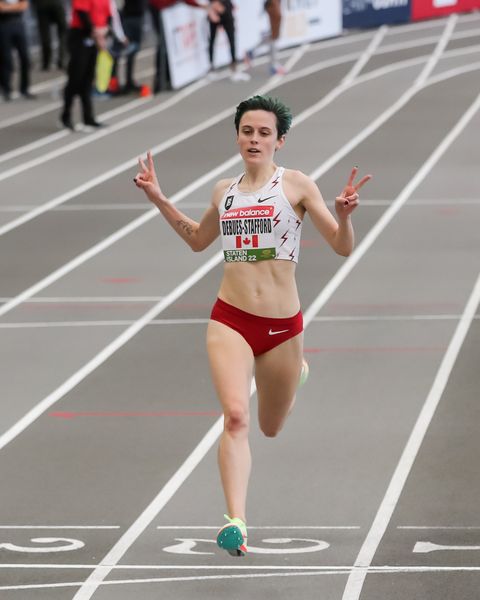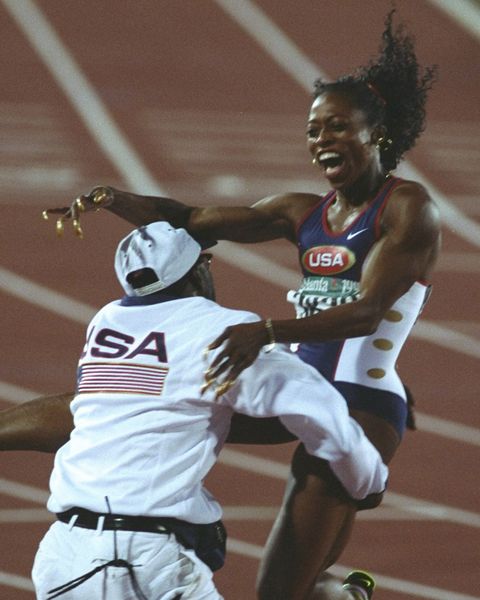At first, Olympic marathoner Jared Ward thought he was just tired. He’s 33, with five kids ranging from 11 months to 9 years old. Surely, some extra fatigue comes with the territory.
But Ward—a statistics professor—soon began to notice irregularities in his data. His resting heart rate is typically in the high 30s to low 40s early in a marathon training cycle, then decreases as he gains fitness, dipping into the low 30s when it’s time to taper for the big race.
In the past couple of years, though, it’s hovered close to 30, even in the offseason.
Last summer, as he prepared for the 2021 New York City Marathon, interval workouts like 800-meter and mile repeats still went fairly well. On his typically strong tempo and long runs, though, he struggled.
The last straw was the USATF 20K championships, held Labor Day weekend in New Haven, Connecticut. He finished in a disappointing-to-him 1:01:20, for 16th place, nearly two minutes off his personal best. “I thought, ‘This just doesn’t feel right. I’m working hard, and I’m not feeling like I’m used to feeling,’” he said. He came home and booked a doctor’s visit.
Blood tests revealed Ward’s levels of thyroid stimulating hormone, or TSH, were above the range considered normal—a sign of an underactive thyroid. His doctor suggested treatment with low-dose levothyroxine, a synthetic hormone that would replace the one his gland was no longer efficiently churning out.
Ward hesitated. He’s long declined to take supplements; until last fall, he had never even used caffeine.
And this wasn’t just any medication. Though thyroid hormone isn’t banned by anti-doping authorities, physicians and coaches—including, most notably, Alberto Salazar—have been accused of encouraging athletes to misuse it in an attempt to improve performance.
“There’s been this image created in endurance sports that thyroid medication is abused,” Ward said. “Whether or not that’s the case, there’s a stigma.”
So he reached out to friends, including Olympic silver medalist Meb Keflezighi, for advice. Try rest, Keflezighi said.
Ward dialed back his training about 20 to 30 percent and put a priority on sleep. New York went well enough, given the circumstances—he finished 10th, in 2:14:06. But even after three full weeks off afterward, he didn’t feel recovered.
His TSH levels, meanwhile, crept higher—from the high 5s into the 6s (normal levels, on most labs, cut off at 4 or 4.5). This prompted Ward to make an appointment with Shahzad Ahmad, M.D., an endocrinologist in Salt Lake City.
“He took one look at my blood work and a quick ultrasound of my thyroid and he said, ‘You have Hashimoto’s disease,’” Ward said. “I said, ‘What’s that?’ And then I began asking him all sorts of questions.”
How common is thyroid disease—and why is it controversial?
Like Ward, many runners don’t know much about thyroid disease until they find themselves coping with the consequences. Or, thanks to allegations like those surrounding Salazar and the now-shuttered Nike Oregon Project, they may suspect anyone who tinkers with hormone levels is seeking a performance advantage.
Yet Hashimoto’s disease and Graves’ disease, an autoimmune condition that causes an overactive thyroid, “are some of the most common endocrine conditions imaginable,” said sports medicine physician and exercise physiologist Philip Skiba, D.O., Ph.D., author of Scientific Training for Endurance Athletes.
Hypothyroidism (an underactive thyroid) affects an estimated five in 100 Americans, and hyperthyroidism (an overactive thyroid) about one in 100, according to the National Institute of Diabetes and Digestive and Kidney Diseases.
The risks of both are highest for older women, but given their prevalence, they also affect many younger people, including athletes, Ahmad said. Given his office location, near both Brigham Young University and the Olympic Training Center, he sees many Olympic and collegiate athletes with thyroid disease.
Symptoms of thyroid disease—like fatigue, heart rate changes, and mood swings—are often non-specific; diagnosis and treatment can take time and fine-tuning.
What’s more, runners and even physicians may confuse hypothyroidism with the consequences of overtraining and underfueling, said Kathryn Ackerman, M.D., M.P.H., sports endocrinologist and director of the Female Athlete Program at Boston Children’s Hospital.
Add it all together, and thyroid conditions are cloaked in a cloud of confusion and secrecy—a space where some athletes closely guard their diagnoses and prescriptions, others accuse doctors and coaches of trading their long-term health for short-term performance gains, and those in limbo struggle for solutions to symptoms that affect far more than their running.
What is thyroid disease?
The thyroid is a butterfly-shaped organ at the base of the neck that secretes two main forms of hormones. The most prevalent is thyroxine (T4), which is eventually converted into the active hormone triiodothyronine (T3). These powerful compounds work in concert with many other systems to control a wide range of bodily functions, including metabolism, body temperature, heart rate, and menstrual cycles.
Normally, the pituitary gland—a nub of tissue in the center of your brain, just behind your eyeballs—acts as “the hormonal thermostat for the body,” said ultramarathoner Fawn Wolf, M.D., of Providence Endocrinology in Portland, Oregon. When the pituitary senses low levels of thyroid hormones, it secretes more TSH, a signal to the thyroid to step up production. When supplies of T3 and T4 are adequate, meanwhile, TSH drops back into the normal range.
In people with thyroid disease, this hormonal correspondence short-circuits. Sometimes, the root cause is a congenital condition, such as being born without a thyroid; viruses, pituitary diseases, or too much or too little iodine in the diet can also contribute. But most often, the underlying cause is autoimmune: the body’s natural defenses turn to attack the thyroid, instead of foreign invaders.
Hashimoto’s disease—Ward’s diagnosis—is the predominant cause of hypothyroidism. Immune responses destroy cells that produce thyroid hormones, depleting T3 and T4. The pituitary gland responds by producing more TSH, but the call goes unanswered.
Besides low heart rate and fatigue, symptoms vary but include dry skin, hair loss, constipation, and a sensitivity to cold. Many people feel forgetful or have muscle cramps and aches; women may have irregular periods.
Triathlete Sarah Piampiano—who just announced her retirement—was diagnosed with Hashimoto’s disease as a preteen. Before she became a pro athlete in 2012, Piampiano had a career in finance and, she admits, a lackluster self-care routine. Despite symptoms such as a puffy face, disrupted sleep, constipation, and a constant chill—signs far more clear to her in retrospect—she often slacked on taking her medication.
Her athletic transition brought the link between her thyroid and her health into relief. When her hormones weren’t balanced, she’d recover poorly and swell up with extra fluid after hard workouts or races. And, she was prone to low bone density and stress fractures, including one in her femur in 2014. (There’s strong evidence for a link between hyperthyroidism and stress fractures, as well as signs hypothyroidism also affects bone density.)
Meanwhile, with Graves’ disease, the immune system produces antibodies that mimic pituitary hormones. This scrambles the signals in the opposite direction, causing the body to produce more thyroid hormone than it needs. As a result, metabolism and other body functions speed up—hearts race, hands shake, and weight unexpectedly drops.
While many runners mistakenly equate a lighter weight with faster times, an overactive thyroid typically has the opposite effect on performance.
Ask Canadian Olympian and Bowerman Track Club runner Gabriela DeBues-Stafford, who was diagnosed with Graves’ disease the summer between graduating high school and starting at the University of Toronto.
She’d won silver in the 1500 meters at the 2013 Canadian junior championships and was preparing to compete in the Pan American Junior Games when her training took a turn for the worse. She struggled to make it through workouts, and when she did, her heart rate skyrocketed. In the race, she ran 4:53.35, much slower than her personal best of 4:22 but with far more effort. “That was the hardest 1500 of my life,” she said.
At first, she blamed burnout from her extended summer season. But even after a break, she wasn’t sleeping well, felt hot all the time, and couldn’t make it through a run without a bathroom stop. She went to the doctor in search of answers.
What types of test results point to hyperthyroidism, or an overactive thyroid?
Pinpointing thyroid disease requires doctors to put several puzzle pieces together: a patient’s medical history, including when and how their symptoms developed; blood tests to measure TSH and other thyroid hormones; a physical exam; and sometimes, imaging tests. Rather than a single red flag, they’re looking for patterns.
Hyperthyroidism, or an overactive thyroid, usually has a relatively straightforward signature: low TSH and high levels of T3, T4, and antibodies. Doctors might feel or see bumpy nodules on the thyroid or a goiter, an enlarged gland that makes the neck appear swollen.
Sometimes, the picture comes together relatively quickly. When DeBues-Stafford went to the doctor, her weight was down about 10 pounds—and her TSH levels were undetectable. She was referred to a specialist, who found high levels of T4 and antibodies, confirming her diagnosis of Graves’ disease. About three months passed from the time she noticed symptoms until she started treatment.
But in other cases, diagnoses take longer—in Gail Devers’s case, about two and a half years. In May 1988, as a student athlete at UCLA, she broke the American record in the 100-meter hurdles, running 12.61. Weeks afterward, she began developing sores that scabbed over, then gave way to light-colored patches on her face.
Over the months that followed, she experienced a constellation of strange and worsening symptoms. She lost weight without trying, felt mentally fuzzy, and her eyes began to protrude so much they looked open even when she slept—signs of thyroid eye disease, a related condition that often goes hand in hand with Graves’ disease, and with which Devers still copes.
“I stopped going outside,” she said. “I could not stand the way I looked. I covered my mirrors; I didn’t want to see.”
Still, doctor after doctor could find nothing wrong with her. Finally, on one of Devers’s rare excursions outside the house, a team physician at UCLA noticed her visible goiter and told Devers to ask for a TSH test at her next appointment, with yet another clinician. She didn’t even need to; the new doctor took a look at her and said, “I can see you’re a walking thyroid disorder.” Devers cried with relief.
And what about the flip side, hypothyroidism, or an underactive thyroid?
When it comes to hypothyroidism, many situations have clear-cut lab findings: People with hypothyroidism due to Hashimoto’s disease typically have high TSH levels, low levels of T3 and T4, and measurable levels of an antibody called thyroid peroxidase (TPO).
Ultrasounds or similar scans of the thyroid often reveal an unusual appearance, what Ahmad calls a “salt and pepper” mix of inflamed and healthy tissue.
But other cases are cloudier. Some people have symptoms like fatigue and hair loss, but a TSH level within the normal range, Ackerman said. If further blood work reveals high levels of antibodies, they likely have Hashimoto’s disease and will develop hypothyroidism if left untreated.
Other people have an elevated TSH but normal T3, T4, and antibody levels. This is what’s called subclinical hypothyroidism—a term that refers to lab readings, not symptoms, Wolf said. People who have it may or may not feel poorly; hormone levels don’t always neatly align with symptoms.
Endocrinologists—and the clinical guidelines they follow when making decisions—disagree about when patients in this gray zone should start treatment and when to hold off. Often, it’s decided on a case-by-case basis, based on symptoms, overall health, and patient preferences, Wolf said.
For athletes in this boat, Ahmad typically recommends treatment. Even minor thyroid abnormalities can affect heart rate and oxygen use, which clearly impact running performance, he said.
But he’s clear that restoring a person’s hormonal balance doesn’t make them run faster times than they did before they got sick: “We’re just basically trying to get them back to their physiologically normal self,” he said.
How are thyroid diseases treated?
There are several treatment options for Graves’ disease and other types of hyperthyroidism. Often, overactive thyroids are first treated with medications to decrease hormone levels.
Weeks after her diagnosis, DeBues-Stafford began taking the most common of these drugs, methimazole (brand name Tapazole). Some people have difficulty finding the right dosage, but DeBues-Stafford responded well; after about a month, her blood work improved and her symptoms began subsiding.
For some, medication will drive Graves’ disease into remission, and they can wean off it. That wasn’t the case for DeBues-Stafford. She gradually cut back to about a half-tablet every other day, but when she tried to quit completely in 2020, she experienced a relapse, with symptoms that included anxiety and a heart rate that climbed above 200 when she jogged up a small hill.
“So long as I’m running, I should probably be on this medication,” she said. When she moves to the next phase of life, she’ll reconsider—especially because the drug isn’t recommended during pregnancy.
Other options include surgery to remove part of all of the thyroid gland or radioiodine, when patients swallow radioactive pills or liquids to destroy thyroid tissue. By deactivating the thyroid, these treatments typically lead to hypothyroidism.
For hypothyroidism, meanwhile, the standard treatment is medicine to replace the missing hormone. The most common type is levothyroxine, a synthetic version of T4 sold under several brand names, including Synthroid and Levoxyl.
Still, there are nuances, said Margaret Crook, M.D., an endocrinologist at UVA Health in Charlottesville, Virginia. The dosage must be precisely calibrated in each patient. The drug takes about 40 days to reach what’s called a steady state, where blood levels stabilize. So the process can be arduous—trying a dose, waiting six weeks for new lab tests, adjusting, and repeating.
And like other autoimmune conditions, Hashimoto’s disease can have flares, requiring tweaks. “Some patients might go on a low dose and be on a low dose for months or even a couple of years and do great, and then they have some more inflammation in their thyroid gland, and then their dose steps up,” Crook said
Treatment not only helps people feel better in the short term—ideally, within a couple of weeks, Crook said—it also prevents long-term health implications of hypothyroidism, including high cholesterol, fertility problems, and pregnancy complications.
Those types of concerns weighed heavily on Leah Falland, a professional runner for the On Athletics Club in Boulder, before her 2018 diagnosis with hypothyroidism. After a successful collegiate career at Michigan State University, Falland—then Leah O’Connor—noticed “something had shifted.”
Despite minimal changes to her diet or training, she’d gained weight, lost energy, and wasn’t having regular periods. Her face felt bloated, her skin dry, and her hair fell out. She couldn’t sleep, and struggled with anxiety and depression—symptoms that, she believes, led many doctors to disregard her other complaints.
Blood tests showed a TSH within the normal range, as well as low levels of ferritin and vitamin D, for which she took supplements to restore. Still, her symptoms persisted, even when she was injured and barely running at all.
“It basically felt like my body just didn’t want me to be a runner anymore,” she said. The idea of giving up her career was devastating, but more than anything, she feared for her future fertility and health.
Even with a cautious approach to rebuilding her body post-injury—focusing on sleep, nutrition, weights, and cross-training—she sustained a stress fracture in her femur in September 2019. That’s when she and coach Dathan Ritzenhein turned to exercise physiologist Krista Austin, Ph.D., a Colorado Springs-based health and performance specialist who has worked with elite endurance athletes like Keflezighi, as well as corporations and Olympic teams.
Austin isn’t a physician with prescribing powers, but she worked with Falland and her doctor in Grand Rapids to start putting the pieces together. Falland’s TSH levels had crept up slowly over time, and her symptoms aligned with those of hypothyroidism, so she started treatment with a low dose of Synthroid. Within a month, she began sleeping better, got her period back, and felt a “general sense of wellness” restored, she said.
The road from that point to her 2021 season—one capped by a strong performance in the 3,000-meter steeplechase at the Olympic Track & Field Trials, where she was on track to make the Olympic team before she fell with 800 meters to go, and a subsequent personal best of 9:16.96—was still bumpy, marked by monthly blood tests, gradual training increases, and ongoing attention to factors like diet and regular menstruation.
“It wasn’t, like, a magical pill. It just started to give my thyroid a little bit of assistance to help my body get back up and going,” she said. “But it definitely has changed the direction of my life and my ability to just feel well.”
What’s the link between thyroid hormones and underfueling?
Overtraining and underfueling—either unintentionally or because of restricted eating or an eating disorder—also may result in disruptions to thyroid hormone levels. But this isn’t thyroid disease, Ackerman said.
In this case, hormonal abnormalities aren’t the cause of the problem, but signs of a completely different condition called relative energy deficiency in sport (RED-S). Here, athletes aren’t taking in enough calories to cover the demands of their training.
Lab tests for athletes with RED-S often show low levels of T3. Their TSH and T4 levels are often low too, but not always; sometimes TSH could be normal or even elevated, Ackerman said. And all these results could change at different points in a training cycle.
So, it might take several tests—and a clinician who’s well versed in the subtleties of sport—to untangle the underlying causes. “You have to look at the whole picture and ask about the training plan, you have to ask about how much they’re eating,” Ackerman said. “You’re looking at a whole pattern.”
The treatment for RED-S and overtraining is “not to stuff you full of hormones artificially to try and balance things out,” Skiba said. “What you need to do is stop training, or train at a more reasonable level.” Attention to nutrition is also critical—Ackerman refers athletes to a registered sports dietitian to evaluate and address their intake.
It’s possible a dose of thyroid hormone could allow an athlete to overtrain for a short period of time, Ackerman said, as well as to lose weight and have more energy. But using it when the thyroid itself isn’t the root cause could have serious health and performance implications. Adjusting hormone levels to patch over the true problem leaves athletes vulnerable to the constellation of other health issues that result from RED-S, including low bone density, infertility, and heart problems.
Can running cause thyroid disease?
One other question many athletes have: Does hard training cause more lasting changes in thyroid function, including triggering autoimmune diseases like Hashimoto’s disease or Graves’ disease?
Right now, there’s no evidence that’s the case, Ackerman said. For instance, a 2015 survey of female runners found no link between hypothyroidism and high-mileage or intense training. Wolf agrees: “People aren’t doing things that cause their thyroid disease,” she said. “It’s going to happen regardless.”
But based on the athletes she’s worked with, Austin wonders if long-term overtraining—especially without enough fuel—might indeed cause more permanent alterations, and others say it’s plausible.
“You inherit your immune system, so you have a genetic predisposition toward autoimmune disease,” Crook said. Stressful situations often tip the balance. “I personally have not seen a patient triggered by hard training, but I would consider that a stress to the body, and so that could potentially trigger an autoimmune disease.”
Is thyroid hormone performance-enhancing or not?
Right now, there’s no consensus and plenty of questions. Many experts say the benefits are unclear at best—and the risk to an athlete’s health for trying, significant.
For one thing, the link between thyroid hormone, weight loss, and improved performance is far from direct, Skiba said. “You could dope someone to the gills with thyroid hormone and you’ll probably get them to lose weight,” he said, but as athletes like Devers and DeBues-Stafford can attest, that doesn’t automatically lead to faster times. “You’ll probably also give them a heart condition and bulgy eyes and, in the long term, decrease their performance.”
Crook points to the difficulties in dosing. Small amounts of extra thyroid hormone would likely cause the body to adjust its thermostat; the pituitary would secrete less TSH, prompting the body to ramp down production of natural hormone, Crook said. Larger doses, meanwhile, could tip an athlete into hyperthyroidism, with all the health and performance risks that brings—including a high heart rate, muscle breakdown, and weak bones.
“That doesn’t stop bad actors, both doctors and coaches who don’t actually understand what they’re doing, from trying it,” Skiba said.
In 2013, a Wall Street Journal article raised questions about the potential abuse of thyroid hormone by Salazar and Houston endocrinologist Jeffrey Brown, M.D.—although when the duo were later banned for four years, none of their three violations had to do with thyroid drugs. (Austin consulted for the Oregon Project and has authored papers with Brown but hasn’t been implicated in wrongdoing.) British runners have also raised questions about the drug’s misuse by team physicians.
In 2015, USADA and U.K. Anti-Doping asked WADA to add thyroid hormone to the list of banned substances. The agency declined, noting the lack of evidence for performance benefits. Both Austin and Ackerman say more research is warranted—and that if new findings emerge, WADA should reconsider a ban.
If a drug is banned, elite athletes with legitimate health problems who need to take it may apply for a therapeutic use exemption (TUE). (Insulin—life-saving for people with diabetes—falls into this category, Ackerman points out.)
Having to file a TUE for thyroid hormone could prevent both intentional abuse and unintentional harm by requiring thorough medical documentation, and also reduce stigma for athletes who truly need the drug.
“I end up with enough athletes who are scared to either take thyroid hormone or they don’t want people to know,” Austin said—she knows of many, including high-profile runners most fans of the sport would recognize, who closely guard their diagnoses. “We need that to go away because if athletes need to be treated, they need to be treated.”
Indeed, despite WADA’s ruling, a cloud covers these treatments. Another triathlete once told a teammate of Piampiano’s, on a training run, that “Sarah’s only performing as well as she is because she’s on thyroid medication.” After a victory, a coach referred to her as a “thyroid doper” on Twitter.
Even though, in her words, she’s one of “the good ones”—taking a hormone-suppressing medication—DeBues-Stafford also finds herself the target of online speculation. She and Piampiano frequently speak and post about their conditions in hopes of countering misinformation and helping others with thyroid disease.
What else should runners—including non-elites—know about thyroid disease?
Given the vague symptoms and often insidious onset of thyroid disease, runners of all types can face difficulties in getting the right diagnosis and treatment. Fortunately, athletes in touch with their bodies and on top of their data can often spot subtle warning signs earlier than others might.
Crook, a longtime runner who has Graves’ disease, first noticed the effects on her training while she was in medical school. Her muscles were weak, her breathing labored, and her times slower. “I couldn’t keep up with my husband anymore,” she said. “That was a big red flag.”
Based on her experience, Devers recommends writing down all your symptoms to share with your doctor—and not settling if you’re told nothing’s wrong. “You have to push for what you believe and what you know,” she said. Also speak up if you have a family history of thyroid disorders or autoimmune diseases, which increases your risk for thyroid disease.
While you might start with your primary care doctor, seeing an endocrinologist—one with experience treating athletes, if possible—can help you untangle the causes of your symptoms and find relief, Ackerman said.
Even non-elite runners can develop RED-S, and specialists can help you determine if the root cause of your problems is a malfunctioning thyroid or overtraining and underfueling, Ackerman said. Tell your doctor you’re a runner, and describe how much you train. And ask questions if you’re prescribed thyroid hormone based on a single lab result, especially one that includes only TSH.
Once you’re diagnosed with thyroid disease, you might have to modify your training while you get your condition under control. With hyperthyroidism, high heart rates can lead to problems like atrial fibrillation, an abnormal heart rhythm that increases your risk for heart attacks and stroke. For instance, DeBues-Stafford had to keep her heart rate below 160—which, at the time, allowed for only the easiest of jogs—when she was first diagnosed.
In addition, thyroid diseases are lifelong conditions. You may need periodic blood work, and dosage adjustments, as your condition progresses or flares. Continue to keep tabs on your symptoms, Crook suggests, and report any new setbacks to your health care team.
Falland knows this winding path from experience. After the successes of 2021, she entered 2022 struggling with lingering plantar fasciitis, low energy, mood disruptions, and poor sleep. Blood tests revealed new abnormalities in her thyroid levels.
Her health care team made an adjustment to her Synthroid dosage, and Falland cut gluten and dairy from her diet to reduce inflammation. In April, she’ll meet with a rheumatologist for more testing and a better understanding of the autoimmune underpinnings of her condition. The roller-coaster ride has been rough, she said, but she feels confident she can ride out the dips again.
Indeed, by being a runner in the first place, you’ve strengthened your muscles and heart, which can help you overcome setbacks, Wolf said. Even runners with severe thyroid disease have returned to the sport they loved—and successfully.
After her relapse in 2020, DeBues-Stafford resumed taking her medication. In February, she set the Canadian record in the indoor 3,000 meters and the North American record in the indoor 5,000 meters on back-to-back weekends.
Eventually, despite a negative reaction to radioactive iodine that caused severe blisters on her feet and set her back further, Devers also stabilized. She went on to win Olympic gold in the 100 meters in Barcelona in 1992 and Atlanta in 1996, where she also won a third gold in the 4×100-meter relay.
As for Ward, he finally went and filled his prescription. Still, he waited two weeks before taking his first dose, continuing to wrap his mind around the need to ingest such a substance.
“How I reconciled that was thinking—you know, this is a condition that I have. I’m going to have to take it eventually, likely, in my life, as this gets worse,” he said. “I want to feel good, and I want to have energy, not just for running, I want to have that at home and with my kids and everything else that I’m doing. And so I want this regulated.”
Ward began treatment with 50 micrograms of levothyroxine in early January, and felt better by February. Blood tests revealed his TSH had decreased but was still elevated—it went from 6.6 to 4.8—and his high antibody levels hadn’t budged. So, Ahmad increased his dosage to 75 micrograms.
Now, he’s once again sailing through race-pace workouts in preparation for next month’s Boston Marathon—and recovering far better afterward, improving his overall quality of life. “I feel six years younger,” he said. “I would for sure advise anyone with hypothyroidism to take seriously the process of getting the condition under control.”
This content is created and maintained by a third party, and imported onto this page to help users provide their email addresses. You may be able to find more information about this and similar content at piano.io





